Natural or Synthetic Vitamin E – Does It Matter?
The vitamin supplement market has boomed over recent years and is expected to reach a global market value of USD 81 billion by 2025 according to Persistence Market Research. Looking at Vitamin E in particular, its origin—natural or synthetic—has been a popular topic of discussion. As consumer interest increases in natural products, vitamin supplements have not escaped public scrutiny over the presence of synthetic versions.
Sources of Vitamin E
Vitamin E acts as an antioxidant and boosts the immune system. It can be found in foods like nuts, vegetable oils and green vegetables. Vitamin E has been used to denote eight different related compounds of tocopherols and tocotrienols. Research has shown, however, that only one form is extracted and used by the body. This form is known as RRR-alpha-tocopherol or d-alpha-tocopherol. The prefixes refer to the spatial arrangement of the elements in the molecule, as different stereoisomers exist but with a different spatial arrangement.
In natural sources, alpha-tocopherol is present in its d form. Many supplements, however, use synthetic alpha-tocopherol, which can be made from cheap petrochemicals. The synthetic form is racemic, an even mixture of stereoisomers, referred to as dl-alpha-tocopherol.
For consumers, differentiation between the Vitamin E sources can be made by checking the label.
The definition of natural and synthetic is also a contentious subject. Although not the case with all vitamins, naturally sourced alpha-tocopherol is chemically different to the synthetic version and, hence, has different biological activity. Since it has been found that the d-alpha-tocopherol is the form with the highest efficacy, the synthetic Vitamin E has a much lower effect and benefit.
Vitamin E – Natural vs Synthetic
 Vigilance on the part of both consumers and manufacturers of vitamin supplements plays an important role in staying on top of the natural versus synthetic discussion. For consumers, the importance of making informed decisions when it comes to supplements has meant more attention is being paid to labels and ingredient lists. For manufacturers, there is a responsibility to ensure the quality of the products and to be able to back up any claims that are made. This is important to keep the consumer confidence high.
Vigilance on the part of both consumers and manufacturers of vitamin supplements plays an important role in staying on top of the natural versus synthetic discussion. For consumers, the importance of making informed decisions when it comes to supplements has meant more attention is being paid to labels and ingredient lists. For manufacturers, there is a responsibility to ensure the quality of the products and to be able to back up any claims that are made. This is important to keep the consumer confidence high.
As consumer interest in natural products increases, so does the incentive for economically motivated adulteration. Catching adulteration can be tricky as methods are constantly evolving. Having independently verified testing done to authenticate any “natural” claims can be a part of a robust quality assurance program and in the long-term, safeguard the all-important bottom line.
Vitamin E provides a compelling case for the push toward clean labels and transparency. Firstly, there is the question of specific content since Vitamin E has been used to denote a range of compounds. Secondly, there is the differentiation between the natural (d) and synthetic (dl) versions of the key compound alpha-tocopherol. Lastly comes the task of quality control, how is authenticity being checked?
Beta Analytic and Natural Product Analysis
Carbon-14 testing is a way to differentiate between natural-sourced material from plants or animals versus petrochemical-derived materials. As a weakly radioactive isotope of carbon-12 that is produced continually in the atmosphere, carbon-14 is present in all living organisms in a known amount. Once no longer living and, therefore, no longer part of the carbon cycle, the amount of carbon-14 decays in accordance with its radioactive decay half-life. Petroleum and its derivatives are sufficiently old that they no longer contain any carbon-14. Measuring the carbon-14 content is therefore an easy test to determine the percentage of a product that is made from natural versus petrochemical-derived synthetic sources.
Beta Analytic is an ISO 17025-accredited laboratory that offers natural product testing of vitamins and other supplements using the carbon-14 method. Results can be accessed online 24/7 along with QA reports.
Expert technical support is available at no additional cost at any point prior to, during or after the analysis. For turnaround time inquiries, call the lab at 305-662-7760 or use this contact form.
References:
Persistence Market Research. 2017. Asia Pacific Projected to Lead the Global Vitamin Supplements Market During 2017 – 2025. Accessed October 2018.
Research and Markets. 2018. Global Vitamin E market – Growth, Trends, and Forecast (2018 – 2023). Accessed October 2018.
National Institutes of Health Office of Dietary Supplements. Vitamin E Fact Sheet for Consumers. Accessed October 2018.
Lelah, M. 2008. National Health Research Institute. Natural vs. Synthetic Vitamin E. Accessed October 2018.
Passwater, R. A. 2016. Wholefoods Magazine. Toward A Better Understanding of Vitamin E Part 1: Clarifying Its Essential Vitamin Role. Accessed October 2016.
Passwater, R. A. 2016. Wholefoods Magazine. A Better Understanding of Vitamin E Part 2: “Natural-Source” and Synthetic Vitamin E. Accessed October 2018.
This entry was posted on Tuesday, October 9th, 2018 and is filed under Natural Product Testing, Supplement Carbon-14 Testing .